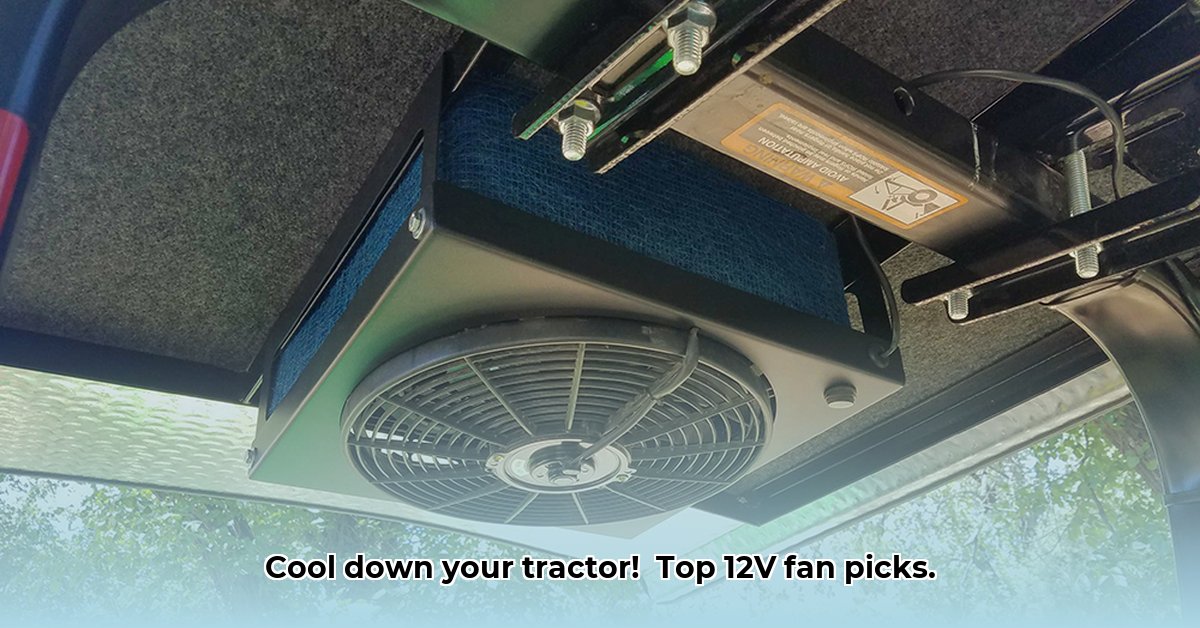
Keeping your tractor's engine cool is crucial for preventing costly repairs and ensuring peak performance. A reliable 12V tractor fan is your first line of defense against overheating, especially during long hours of operation in warm climates. But with a variety of models available, choosing the right one can feel overwhelming. This comprehensive guide helps you navigate the selection process, providing expert insights and actionable advice to find the perfect fan for your tractor. For information on 12V tractor batteries, check out this helpful resource: 12V Battery Info.
Understanding Your Tractor's Cooling Needs
Before you even start browsing, it's vital to understand your tractor's specific cooling requirements. Several factors influence the necessary airflow:
Tractor Size and Type: A small compact tractor will have different cooling needs than a large agricultural tractor. Larger tractors naturally generate more heat and often work under more strenuous conditions.
Workload and Operating Conditions: Intensive tasks in hot and humid climates demand higher CFM (Cubic Feet per Minute) ratings than lighter work in cooler temperatures. Think about your typical workday length and the intensity of your operations.
Cab Size and Design: Larger cabs require more powerful fans to effectively circulate air and maintain operator comfort. A poorly ventilated cab can lead to excessive heat buildup, impacting both efficiency and driver well-being.
Don't underestimate the importance of properly sizing your fan. An underpowered fan will struggle to keep up, leading to engine overheating. A well-chosen fan, however, will significantly enhance both the lifespan of your engine and operator comfort.
Key Features to Consider
Beyond CFM, several other crucial features distinguish different 12V tractor fans:
Mounting Options: A Secure Fit Matters
Most fans offer either universal or tractor-specific mounting. Universal mounts are adaptable to a wider range of tractors but might need adjustments for a perfect fit. Tractor-specific mounts guarantee a snug, secure installation designed for your model. Consider how easy it will be to install and the long-term security of the chosen mount.
Speed Control: Tailoring Airflow to Your Needs
Multiple speed settings allow you to adjust airflow based on the operating conditions. High speeds provide maximum cooling but increase noise, while lower speeds are quieter but may not offer sufficient cooling under extreme conditions. A variable speed setting allows for optimal energy usage and noise reduction.
Durability and Build Quality: Investing in Longevity
The fan will likely face harsh conditions, including vibrations and exposure to dust and moisture. Durable construction, often from robust materials like reinforced plastic or metal, is essential for long-term reliability and reduced maintenance.
Additional Features: Enhancing Functionality
Some fans include extra features, such as defrost capabilities (particularly helpful in winter) or integrated switches. These extras add convenience but may increase the overall cost. Evaluate your specific needs to determine if these features justify the added expense.
Comparing Different 12V Tractor Fans
The following table compares hypothetical models (specifications vary greatly between brands and models – always check manufacturer details):
| Feature | Model A | Model B | Model C |
|---|---|---|---|
| CFM Rating | 1500 CFM | 2000 CFM | 2500 CFM |
| Mounting Type | Universal, Adjustable | Tractor-Specific | Universal, Fixed |
| Speed Settings | Two | Three | Single |
| Defrost Capability | No | Yes | No |
| Price | $50 | $75 | $100 |
Remember: This is a simplified comparison. Always consult manufacturer specifications for accurate details and compare multiple sources.
Selecting and Installing Your 12V Tractor Fan: A Step-by-Step Guide
Installing a new fan is generally straightforward, but attention to detail is key:
Assess Your Cooling Needs: Determine the CFM required based on your tractor's size, workload, and operating conditions.
Compare Fan Models: Carefully review specifications and features from multiple manufacturers. Read user reviews to gauge real-world performance.
Choose the Right Fan: Select a fan that balances performance, budget, and desired features (mounting type, speed settings, etc.).
Verify Compatibility: Double-check compatibility with your tractor model. Consult your tractor's manual and the fan's installation instructions.
Gather Tools and Materials: Assemble the necessary tools and materials (screwdrivers, wrenches, potentially electrical connectors).
Install and Wire the Fan: Follow the manufacturer's instructions meticulously. Pay close attention to wiring connections to avoid electrical issues.
Test the Fan: After installation, run the tractor to verify proper operation, airflow, and the absence of unusual noises or vibrations.
Regular Maintenance: Clean the fan blades and shroud periodically to remove dust and debris, ensuring optimal performance and extending the fan's lifespan.
Mounting Options: Universal vs. Tractor-Specific
Choosing between universal and tractor-specific mounting involves weighing pros and cons:
Universal Mounting:
- Pros: Wider compatibility, easier replacement.
- Cons: Requires adjustments for a perfect fit, may be less secure.
Tractor-Specific Mounting:
- Pros: Perfect fit, secure installation.
- Cons: Limited compatibility, replacement might be harder to find.
Conclusion
Choosing the right 12V tractor fan is essential for maintaining engine health and operator comfort. By following these steps and understanding your cooling needs, you can select a fan that ensures your tractor stays cool, runs smoothly, and lasts for many years to come. Continue to research advancements in tractor cooling technology for future improvements.